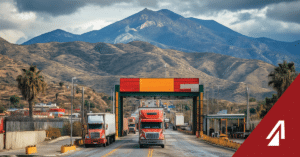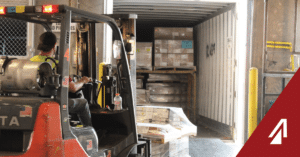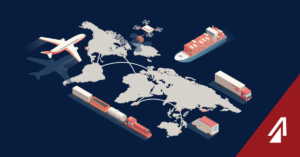Oftentimes, looking through logistics news and industry reports, “driver shortages” is a glaring issue that stands out among the bevy of current supply chain crises. Looking at many of the bare store shelves, proves this to be the case. Lack of products is not the issue – we still see congestion at the major US ports, with thousands of containers being offloaded and set aside waiting for pickup and distribution. Without the driver base to collect and deliver these to their customers, the product is basically unreachable and useless. This, combined statistics like DAT Trendlines roughly 3.9:1 national load to truck ratio or retail giant Walmart offering $100,000+ salaries for drivers, shows that drivers are in demand. The next questions though, are how bad the shortage is, why is there a shortage, and what can be done about the shortages.
How Bad is the Driver Shortage?
On its face, this seems like a simple question – how many drivers are there, versus how many are needed to fill the current demand. What complicates this answer is who you ask. For instance, some supply chain executives and industry writers claim there is not actually a driver shortage, rather a cyclical pattern of leanness and bloat that relies on having the right number of drivers in the right place at the right time. Others state the drivers are available but are not working for larger carrier organizations, favoring instead to become owner operators. Lastly, some view the question too broadly and state that the right question is not about total drivers needed, rather the number of over the road drivers needed.
This writer will try and be as black and white as possible and address the most critical question of how many over the road drivers are needed. That answer is simple – according to the American Trucking Association (ATA), the US is facing a nearly 80,000 driver deficit for over the road operations. This is a historic high. Projections for the coming decade estimate that number will double if conditions fail to improve as driver demand and expectations increase. The ATA estimates that it carriers will need to hire as many as 1,000,000 new – not circulating – drivers over the next 10 years to keep up with retirements, voluntary and involuntary separations, and additional industry growth. But, looking at the why behind the driver shortages might prove filling those seats difficult.
Why the Driver Shortage?
There is no single reason as to why there are driver shortages. The ATA breaks down the most common reasons into demographics, lifestyle, regulations, and infrastructure.
When looking at demographics, the majority of the current driver base is older men nearing retirement age. These workers are often more willing to accept retirement rather than cope with continuing a grueling lifestyle or adapting to new restrictions or regulations like those brought on by the COVID 19 pandemic – even with the promise of higher wages. Other demographic information shows that women are underrepresented in the driver workforce. Only 7% of drivers are women, and that is well below the average for female representation in the workplace.
For lifestyle, some of the most reported reasons to leave trucking are time away from home or family as well as living conditions on the road. Other issues, like drug and alcohol problems also preclude workers from driving. According to the Drug and Alcohol Clearinghouse, a federal program for monitoring drug and alcohol violations, as many as 93,808 drug and alcohol related violations were recorded since January of 2020. Of that 93,808, only about 20,000 of these drivers have done what is necessary to reinstate their licenses. Another lifestyle issue is that carrier standards for entry reject many potential drivers for driving record or criminal background history.
Current regulations put burdens on drivers. Regulations like greenhouse gas emissions, mandatory minimum driving ages, and pandemic restrictions have either driven drivers from the workforce or are preventing potential drivers from joining the workforce.
Lastly, infrastructure is an often overlooked, but critical issue that causing many drivers to leave the workforce. Each year, the American Transportation Research Institute (ATRI) publishes a report of the top industry concerns for carriers, drivers, and the industry as a whole. Consistently, for the past 4 years, parking has made the top 10 for driver concerns. Without adequate parking, drivers risk safety concerns of parking on highway shoulders or ramps or wherever they can find a place. Drivers also must reduce the number of hours they drive in order to find a parking place to not violate hours of service regulations – this cuts into their pay. This problem is also exacerbated by detention and dwell times at shippers preventing drivers from finding agreeable parking accommodations within the allowed HOS timeframe.
Each of these as a standalone issue is reason enough for many drivers to leave the industry, but these issues often compound with one another and make the driving experience worse. They offer enough disincentives that when drivers are faced with another employment opportunity, many would rather try something else instead. They also are a deterrent to many new employees looking for work. So, what can be done?
For one, the COVID-19 pandemic caused complete disruptions throughout most of the entire world’s supply chains. Channels for goods and services were blocked up and down stream and many were not able to compensate. Finding new suppliers significantly drove up rates for goods and services in every market sector, not just logistics. Lockdowns and labor shortages added to an already exacerbated marketplace to prevent many goods from moving at all. These contributed to port closures, port congestion, lack of new containers, lack of capacity, and other factors making doing business difficult and unpredictable. Even today, consumers can see the ripple effects of labor shortages at some of the United States’ largest ports, Ports of Los Angeles and Long Beach. Both the ports and the state of California are struggling to staff the port to unload the 100+ ships at dock and have drivers available to carry the freight to its final destination once it is unloaded. Each of these compounds the problem of moving shipping containers and rising prices.
Another issue is underutilization. In 2021, the Asian market imported 40% more goods to the US than it had in 2020 and before. Meanwhile, the US exported the same amount it had before. Meaning, there was a significant imbalance for trade. Like domestic transport, international carriers cannot afford to run empty and deadhead to the next pickup. So, costs for running underutilized were passed on to the shippers and manufacturing consumers as well.
Lastly, general inflation combined with increased government regulation has significantly added to shipping prices as well in terms of taxes and fees placed on the carriers. The carriers in turn pass those costs on to the consumer.
What Can Be Done?
One of the most valuable things to understand right off, is that money alone will not fix the problem. According to the Bureau of Labor Statistics and DAT trendlines, driver wages are up. They have grown at a pace 5 times higher than the national average over the past few years. Yet, with more money, there are still fewer drivers and this complicates staffing and human resource managers’ jobs filling the empty positions. What needs to change are hiring and recruiting practices, drivers’ lifestyle and perceptions, and significant infrastructure and regulation evaluation.
When hiring and recruiting, carriers need to think outside of the box. Some companies are staffing 24/7 recruitment staff or have multi-lingual staff available to interview and hire potential drivers. Others are evaluating their hiring incentive packages with more home time or other benefits. A potential option would be to find a way to target underrepresented markets like women. One of the most important practices a carrier can adopt is loyalty to their drivers and advocate for them to shippers and receivers for detention and dwelling issues and treatment, as well as to the local, state, and federal government for ease of regulations and restrictions. Building a relationship with a driver and providing for their concerns can offer greater incentive to loyalty than simply offering a raise.
Another important practice to gain and retain drivers is to improve the drivers’ lifestyle as well as the public perception of what driving is. Carriers and industry specialists need to work with drivers and the public to make driving less grueling and present the benefits to potential employees. They must work with the public to address driver concerns like parking, detentions and delays, training issues, or driver distraction. They must also work to sell the benefits of driving to potential employees like higher wages, improved work/life balance, and freedom and adventure. Once these can be improved, the job of driving can be more attractive to potential drivers, and these positions can be filled.
Lastly, carriers must advocate to their governing bodies on behalf of their drivers. There are a host of issues that carriers and drivers are constantly involved in with the government (at each level), and it is vital that companies stay up to date with the regulations and restrictions that affect their workers. Legislation, like the Infrastructure Bill, must include language that allocates for necessities like truck parking. Drivers and carriers must make their voices heard when it comes to potential laws or regulations that dictate the day-to-day operations so that conditions are still practical and bearable. The average person does not necessarily know what drivers face, so it is important that the industry speaks for itself to the government. Then, hold the government accountable once change has been promised.
Private firms, like many of today’s ocean carriers, are taking a different approach. Many carriers are using the profits from 2021 to invest in new equipment – ships, containers, etc – to increase capacity and ease the strict supply. These efforts are slow, however, as it takes approximately 18 months for a new ship to be built.
The issue of increased international freight costs is a significant one. The pandemic has revealed significant issues in the already volatile logistics marketplace. Whether through lack of competition or by other competing factors, the fact remains that prices are rising, and experts agree that it may be some time before they come back to normal.
Overall, the outlook for the current driver shortage is murky. There are significant shortages now and greater ones on the horizon if nothing changes. So, it is important to see and understand why the shortages are taking place now, so changes can be made to avoid disaster later.



